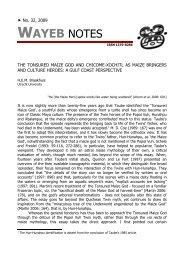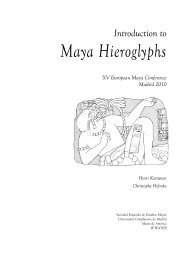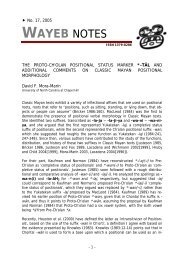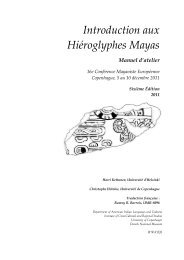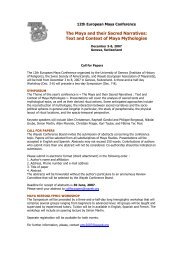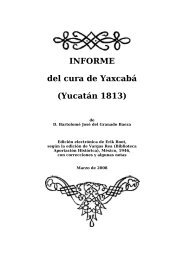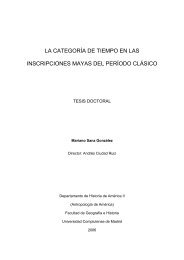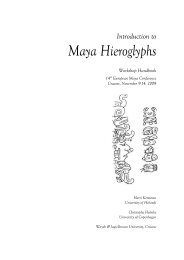Create successful ePaper yourself
Turn your PDF publications into a flip-book with our unique Google optimized e-Paper software.
� <strong>No</strong>. <strong>14</strong>, 2004<br />
WAYEB NOTES<br />
ISSN 1379-8286<br />
A PRELIMINARY RULING SEQUENCE OF COBÁ, QUINTANA ROO<br />
Sven Gronemeyer<br />
Institut für Altamerikanistik und Ethnologie (IAE)<br />
Rheinische Friedrich-Wilhelms-Universität Bonn<br />
Introduction<br />
The archaeological site of Cobá is located in the western part of the Mexican state of<br />
Quintana Roo near the border to Yucatán. Due to its impressive site center, about a<br />
dozen outlying major satellites connected by a causeways with the nuclear zone, and<br />
two long range sakbeo’ob to Ixil and the 100 km distant center of Yaxuná, Cobá is<br />
believed to be one of the biggest Maya sites in the entire Maya lowlands. Based on<br />
the model of subzones proposed by Antonio Benavides (1981a: 23-24, 1981b: 185f.),<br />
esteems attribute Cobá an urban expansion of at least 70 km 2 .<br />
Research in the archaeological site was, among others, conducted by the Austrian<br />
explorer Teobert Maler (1997: 221-222), the Carnegie Institution of Washington<br />
(Gann 1926: 103-128, Thompson, Pollock and Charlot 1932, Villa Rojas 1934), the<br />
Coba Archaeological Mapping Project of the National Geographic Society (Folan, Kintz<br />
and Fletcher 1983), and the INAH (Benavides 1981a, 1981b) up to the present day<br />
(cf. José Con and Martínez Muriel 2002).<br />
Epigraphy of Cobá<br />
Up to the present day, 34 stelae and several panels with traces of hieroglyphic inscriptions<br />
have been unearthed, most of them have been published in the CMHI<br />
(Graham and van Euw 1997). Remains of painted texts upon stucco have also been<br />
uncovered. Since the prevailing majority of the monumental hieroglyphic records of<br />
Cobá have been carved on a local limestone of poor quality, the state of preservation<br />
is merely sufficient to regain valuable historical information. A great part of the calendrical<br />
accounts have nevertheless been discussed by Sylvanus G. Morley (1927)<br />
and above all by Eric Thompson (Thompson, Pollock and Charlot 1932). As for the<br />
non-calendrical contents, only very recently attempts have been made to retrieve<br />
information from the heavily eroded monuments of Cobá (cf. Lacadena 2003).<br />
Aim of this note and methodology<br />
Within this note, I will make the attempt to establish a preliminary dynastic sequence<br />
for Cobá. Unfortunately, no key expressions for the demarcation of distinctive rulers<br />
can definitely be made out in the texts, such as birth, inauguration or death. The<br />
- 1 -
pioneering historic method first utilized by Tatiana Proskouriakoff (1960) fails in the<br />
corpus of Cobá due to the fragmentary state of well readable glyphic blocks. Even<br />
distance numbers can hardly be utilized to establish a source immanent calendric<br />
nexus.<br />
The only possibility to get information on rulers in a relative dynastic sequence is to<br />
separate them by a sufficient gap in time. In a second step, monuments with nearby<br />
dates, preferably with a temporal overlapping, might be attributed to a single individual.<br />
<strong>No</strong>t until the clustering of monuments and their dates is achieved, the recognition<br />
of historical events can be used to crosscheck this grouping and to ensure that<br />
the acting protagonist is indeed a ruler. But this last step should not be overestimated.<br />
Again it has to be stressed that such recognitions have no strong affirmative<br />
character in the heavily eroded inscriptions.<br />
With the aid of the methodology described, it was possible to pinpoint three distinctive<br />
rulers in the corpus of Cobá. In the following paragraphs these rulers, named<br />
consecutively by letters from A to C, will be presented by means of the retrieved information.<br />
Ruler A<br />
Figure 1: Cobá Stela 6. In: Graham and van<br />
Euw 1997: 37.<br />
- 2 -<br />
Stela 6 (Figure 1) opens in blocks A1-B7<br />
with an Initial Series date 9.9.0.0.0, 3<br />
Ajaw 2 Sotz’ (May 12, 613). Without<br />
interruption, a second Initial Series follows<br />
directly behind in blocks A8-D2<br />
and denotes the half-period 9.9.10.0.0,<br />
2 Ajaw 13 Pohp (March 21, 623). At the<br />
end of the text, in blocks G11-G12 there<br />
can be made out a stative phrase.<br />
G12 opens with a statement which apparently<br />
reads u-mam, “his grandfather”<br />
followed by the personal name of<br />
him, according to the general structure<br />
of relationship expressions. Ruler A as<br />
the subject of the texts must therefore<br />
be named in blocks G?-G10 and is<br />
surely depicted with the standing figure.<br />
Stela 4 (Figure 2) can also be connected<br />
to Ruler A, since it bears the same<br />
9.9.10.0.0 date as Stela 6. There is a<br />
calendar round denoted in blocks I6-I7,<br />
followed by a verbal expression introducing<br />
the sign T713a k’al in I8. This<br />
verb is in most instances connected either<br />
with the inauguration of a ruler or<br />
period ending rituals. Since the combination<br />
of the numeral coefficients 4 and<br />
17 in the calendar round do not allow a<br />
period ending with the day sign ajaw, a<br />
historical account is probably. This assumption<br />
finds further confirmation with
lock I9 that highly resembles the<br />
outer shape of the prepositional expression<br />
tu baah. An accession into<br />
rulership is therefore highly plausible<br />
and may refer to Ruler A. Unfortunately,<br />
the calendar round cannot be<br />
fixed securely in the Long Count notation.<br />
Ruler B<br />
Separated by a time gap of 30 years,<br />
Stela 1 (Figure 3) has been identified<br />
as a testimony of the next individual,<br />
Ruler B. This monument bears a very<br />
long inscription on all four sides and<br />
incorporates four single Initial Series<br />
dates in a single inscription, a feature<br />
shared only with COB St. 5 in the<br />
Maya corpus.<br />
The front side opens with the Initial<br />
Series date 9.11.0.5.9, 4 Muluk 17<br />
K’ayab (January 31, 653) in blocks<br />
A1-B9. In blocks G7-H13 the date<br />
9.12.10.5.12, 4 Eb 10 Yax (August<br />
30, 682) appears. The back face of<br />
Stela 1 opens with one of the most<br />
remarkable Initial Series dates denoted<br />
on a Maya monument, the<br />
elaborate creation date 13.0.0.0.0, 4<br />
Ajaw 8 Kumk’u (August 13, 31<strong>14</strong> BC)<br />
in blocks M1-N17. Its 25 period denominations<br />
are followed in block<br />
M18 by the “creation verb” T153 and<br />
the period ending expression tzutz in<br />
block M19. The fourth Initial Series<br />
date appears in blocks O6-??, identifiable<br />
as 9.12.0.0.0, 10 Ajaw 8 Yaxk’in<br />
(July 1, 672).<br />
<strong>No</strong> historical information may be retrieved<br />
for the non-mythical dates,<br />
since many parts of the inscription are<br />
Figure 2: Cobá Stela 4. In: Graham and van Euw<br />
1997: 31.<br />
eroded. Since it obvious that the date 9.12.0.0.0 is denoted for the commemoration<br />
of the K’atun-ending, the other two dates 9.11.0.5.9 and 9.12.10.5.12 are of historic<br />
nature and must describe events in the life of Ruler B. The text might be structured<br />
in the following way with the aid of the Long Count dates. Of course I am aware that<br />
this interpretation is highly speculative, but at the same time of some plausibility.<br />
The first date 9.11.0.5.9 might be connected with the accession of Ruler B, who then<br />
celebrated the 12-K’atun-ending as ruler with a linkage to the creation event on<br />
- 3 -
13.0.0.0.0. The last date, 9.12.10.5.12 might then describe an important event during<br />
his reign, eventually his death. If this should hold true, Ruler B would have been<br />
29 years in office, not an untypical span. Since most inscriptions in Cobá open with a<br />
round date, this stela is seen as the tale of another individual.<br />
Figure 3: Cobá Stela 1. In: Graham and van Euw 1997: 18-24.<br />
Figure 4: Cobá Stela 5. In: Graham and van Euw 1997: 33-36.<br />
- 4 -
Stela 5 (Figure 4) is also of interest, since it also incorporates several Initial Series<br />
dates. The front side opens with the notation of 9.11.10.0.0, 11 Ajaw 18 Ch’een (August<br />
23, 662) in blocks A1-B9. It his probable that the back face also opened with a<br />
Long Count date which cannot be determined. This side incorporates another date in<br />
blocks K2-K10 which can only be gives as 9.11.?.0.0, ? Ajaw ? ? due to heavy erosion.<br />
Like on Stela 1, the right side of Stela 5 displays a long notion of the creation<br />
date 13.0.0.0.0. Since the dates of Stelae 1 and 5 overlap, the latter one can also be<br />
attributed to Ruler B.<br />
Ruler C<br />
Separated by a considerable gap in time of more<br />
than 100 years to the inscriptions of Ruler B, the<br />
next clear evidence comes from Stela 20 (Figure<br />
5), the best preserved monument from Cobá.<br />
The Initial Series date in blocks A2-D1 can clearly<br />
be identified as 9.17.10.0.0, 12 Ajaw 8 Pax (December<br />
2, 780). Though the following text is<br />
eroded, it presumably described events in celebration<br />
of the K’atun-ending. Most interestingly,<br />
in block C7 the expression u-kab-iji(y) which introduces<br />
the agent of the events denoted, i.e. the<br />
ruler. His name phrase can therefore be made out<br />
safely in blocks E1-F1, though it is unknown if it<br />
extends further. An emblem glyph is also not visible.<br />
The signs are eroded, but considering the<br />
shape and outlines, a reading kaloomte’ chan<br />
k’inich might be plausible.<br />
Stela 16 (Figure 6) opens with an Initial Serie for<br />
which Thompson (Thompson, Pollock and Charlot<br />
1932) has proposed three possibilities: 9.15.1.2.8,<br />
9 Lamat 16 Keej, 9.12.9.2.8, 9 Lamat 11 Yaxk’in<br />
or 9.11.3.2.8, 9 Lamat 1 K’ank’in. Based on the<br />
appearance of specific notations in the Supplementary<br />
Series and arithmetic considerations, I<br />
conclude the date is rather 9.16.7.2.8, 9 Lamat 6<br />
Xul (May 20, 758). Considering the great time<br />
gap between the monuments of Ruler B and<br />
Ruler C, Stela 16 might also be attributed to the<br />
latter one and may then record his birth or inauguration.<br />
Figure 5: Cobá Stela 20. In: Graham<br />
and van Euw 1997: 60.<br />
Discussion<br />
As demonstrated, it has been possible to identify three distinctive rulers in the inscriptions<br />
of Cobá. For one of them, Ruler C, a nominal phrase or at least a part of it<br />
could be isolated and read as kaloomte’ chan k’inich. Personal affairs and stations in<br />
the biography of ruler are hardly to be determined, only fragmentary information,<br />
such as the celebration of period endings are seen or can be derived. In connection<br />
with Ruler A, an accession statement of the form k’al-laj sak hu’n tu baah was notified,<br />
but it cannot be correlated with a Long Count position.<br />
- 5 -
Figure 6: Cobá Stela 16. In:<br />
Graham and van Euw 1997: 53.<br />
Unfortunately, the three identified rulers are also not<br />
in an uninterrupted dynastic sequence but separated<br />
by sometimes remarkable time gaps. Parentage<br />
statements that would help to identify successive<br />
individuals are absent. Though Stela 6 offers the relationship<br />
u-mam, it is not clear whether this mentioned<br />
grandfather was indeed a ruler, since his<br />
nominal phrase shows no titles that would identify<br />
him as such.<br />
Like the internal history of Cobá, the sociopolitical<br />
interactions and relations with other polities remain<br />
obscure. <strong>No</strong> single event can be identified. There is<br />
nevertheless one clue that could shed more light into<br />
the political organization of <strong>No</strong>rtheastern Yucatán.<br />
Several emblematic titles can be seen in the inscriptions.<br />
One of them, ek’aab jo’ (Lacadena 2003) was<br />
proposed as the emblem of Cobá itself by Grube. It<br />
is possible to correlate the site with this emblem, but<br />
definite confirmation still needs to be found. As it<br />
was proposed by Lacadena, the mother of the Ek’<br />
Balam king U Kit Kan Le’k Took’ may be from this<br />
place.<br />
The interactions of Cobá and Ek’ Balam as well with other polities of <strong>No</strong>rtheastern<br />
Yucatán may also be derived from the mention of another emblem. It constitutes of<br />
the name of God K, k’awiil. On EKB Msc. 1, a person is depicted and named by a<br />
glyphic caption which ends in k’awiil ajaw. Lacadena (2003) has discussed this part<br />
either as a title or as a part of the personal name. That k’awiil ajaw is indeed an emblem<br />
glyph can be demonstrated by several more references in the corpus of Cobá,<br />
where it appears on Stela 1, H5. More examples combine it with the female personal<br />
classifier ix(ik) as it can be seen on Stela 1, H20 and W21. Possibly, a woman from<br />
the polity of k’awiil married into the Cobá dynasty and was somehow related to Ruler<br />
B. Since Ek’ Balam carries its own emblem tal(o’) (Voß and Eberl 1999), the polity of<br />
k’awiil may somewhere be located between or at the periphery of both centers.<br />
Yaxuná for example may be a good candidate, since it is also connected by a regional<br />
sakbe with Cobá.<br />
Final remarks<br />
The importance of Cobá as a regional capital on the Yucatán peninsula that was deduced<br />
from its sheer size in the archaeological record, finds only a limited confirmation<br />
by epigraphy. Though many stelae with quite long inscriptions are known, their<br />
badly preserved manner make it quite impossible to reconstruct a dynastic and political<br />
history. Maybe an even more closer inspection of the original texts might reveal<br />
another detail in the record. The small sketch presented in this note only summarizes<br />
the results of a quick glance.<br />
- 6 -
References Cited<br />
Benavides Castillo, Antonio<br />
1981a Cobá: Una ciudad prehispánica de Quintana Roo. Mexico City: INAH Centro Regional<br />
de Sureste.<br />
1981b Los caminos de Cobá y sus implicaciones sociales (Proyecto Cobá). Mexico City: INAH<br />
Centro Regional de Sureste.<br />
Folan, William J., Ellen R. Kintz and Laraine A. Fletcher<br />
1983 Coba: A Maya Metropolis. New York: Academic Press.<br />
Gann, Thomas<br />
1926 Ancient cities and modern tribes: exploration and adventure in Mayaland. London:<br />
Duckworth Press.<br />
Graham, Ian and Eric van Euw<br />
1997 Corpus of Maya Hieroglyphic Inscriptions. Volume 8, Part 1: Coba. Cambridge:<br />
Peabody Museum.<br />
Gronemeyer, Sven<br />
2003 Cobá, Quintana Roo, México. Unveröffentlichtes MS., Institut für Altamerikanistik und<br />
Ethnologie, Universität Bonn.<br />
José Con, María and Alejandro Martínez Muriel<br />
2002 Cobá. Entre caminos y lagos. Arqueología Mexicana IX(54): 34-41.<br />
Lacadena, Alfonso<br />
2003 El Corpus Glífico de Ek’ Balam, Yucatán, México. Electronic document,<br />
http://www.famsi.org/reports/01057es/index.html, [October 8, 2003].<br />
Maler, Teobert<br />
1997 Península Yucatán. Edited by Hanns J. Prem. Berlin: Gebr. Mann Verlag.<br />
Morley, Sylvanus G.<br />
1927 New Light on the Discovery of Yucatan and the foundation of the new Maya Empire.<br />
American Journal of Archaeology XXXI(1): 51-69.<br />
Proskouriakoff, Tatiana<br />
1960 Historical Implications of a Pattern of Dates at Piedras Negras. American Antiquity<br />
25(4): 454-475.<br />
Thompson, J. Eric S., Harry D. Pollock and Jean Charlot<br />
1932 A Preliminary Study of the Ruins of Coba, Quintana Roo, Mexico. Carnegie Institution<br />
Publication, 424. Washington: Carnegie Institution.<br />
Villa Rojas, Alfonso<br />
1934 The Yaxuna-Coba Causeway. Carnegie Institution Publication, 436. Washington:<br />
Carnegie Institution.<br />
Voß, Alexander and Markus Eberl<br />
1999 Ek Balam: A New Emblem Glyph from the <strong>No</strong>rtheastern Yucatán. Mexicon XXI(6):<br />
124-131.<br />
- 7 -



